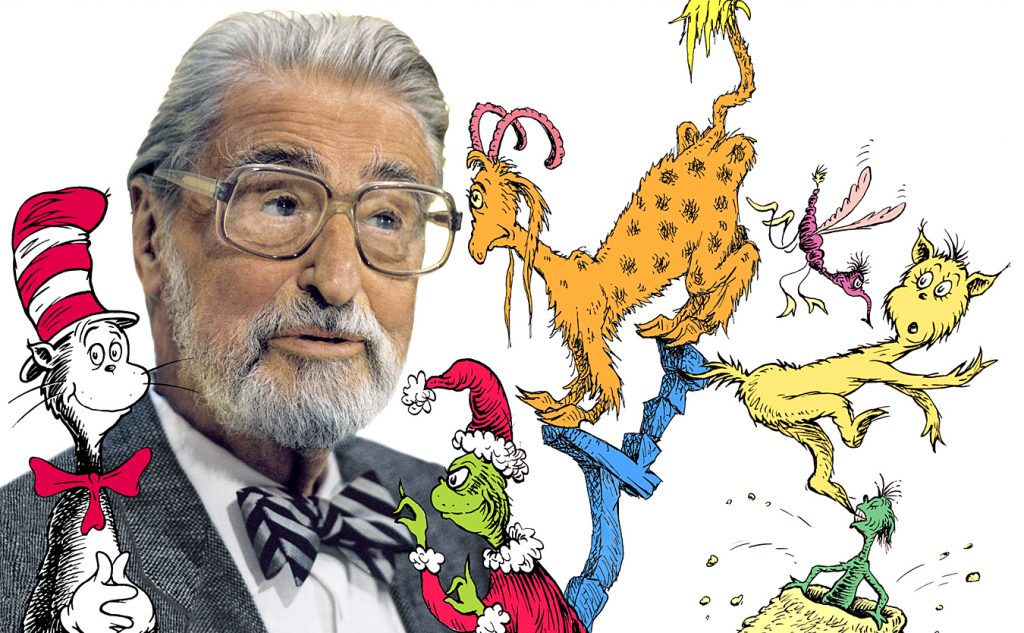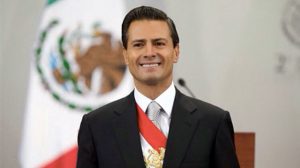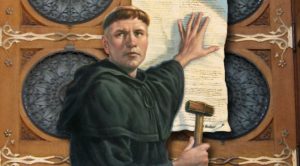Theodor Geisel, beloved children’s author, had a life before he put the hat on the cat. Born March 2, 1904, in Springfield, Massachusetts, Geisel was the only son of German-born immigrants. He spent a normal childhood with his sister and parents, before going to college to become a teacher. Geisel dropped out of college shortly before completing his doctorate in literature. He would eventually turn his almost doctorate and his mother’s maiden name into his now famous pen name, Dr. Seuss.1

In 1927, Geisel decided to turn his passion for drawing and writing into a career in advertising. One of his early successes in advertising was his drawing for Flit insecticide, whose mascot looked very similar to the cat that would eventually wear a striped hat.2 He later created an entire campaign for Essomarine Oil, a division of Standard Oil, called Seuss Navy, in which he designed certificates of membership, pamphlets, and even ashtrays and cocktail glasses that were passed out at trade shows. The Seuss Navy ads ran from 1936 to 1941, and contained many of the sea creatures that would later appear in his books.3 Geisel used many of his made up creatures in various ad campaigns and was the first person to use humor to sell products, altering the advertising industry.4

In 1941, Geisel left advertising to work as a political cartoonist for liberal New York newspaper PM. He drew over 4oo cartoons targeting such topics as isolationism, antisemitism, and racism. He routinely mocked Hitler and Mussolini, but he had a particular flair for attacking American nationalism as well. Believing that the American Nationalist Movement was just another form of fascism, Geisel made Charles Lindbergh a frequent subject of his cartoons.5 After the Japanese attack on Pearl Harbor, Geisel began to use his cartoons to support the war against Japan. He drew cartoons that “depicted Hideki Tojo, the Prime Minister and Supreme Military Leader of Japan, as an ugly stereotype, with squinting eyes and a sneering grin.”6 Geisel was in support of Japanese internment camps and drew several cartoons about them.

It can be hard to imagine that Dr. Seuss could be a racist in his depiction of Asians, but he later admitted that this was exactly the case. At the time, PM did not receive one letter of complaint about Geisel’s stereotypical depiction of Asians, although they received many letters when Geisel mocked the German dachshund, which was popular among American dog owners. Dr. Seuss later said that his 1954 book, “Horton Hears a Who,” written after a trip to Japan and dedicated to a Japanese friend, is meant to be an apology to the Japanese people for his depictions of them during World War II. In the 1980’s, Geisel looked through all his children’s books and removed anything he felt was racist, changing them for any future publication.7
Geisel’s political cartoons ended when he joined the Army in 1943. The now Captain Geisel was assigned to a unit that made training films for the Army, working with the likes of Stan Lee (creator of super heroes) and Chuck Jones (creator of the Road Runner and Wile E. Coyote).8 Geisel and Jones would become life long friends and would work together on various projects, including the animated “How the Grinch Stole Christmas,” which is still shown every year on television.

Geisel’s first children’s book was “And to Think I Saw It on Mulberry Street,” and was published in 1937. However, his writing career almost never happened. The book had been turned down by 27 publishers and Geisel was ready to give up the idea of becoming a children’s author when he ran into an old college friend while walking down the street. His friend had recently become an editor at Vanguard Press and asked Geisel to send him the book so he could show his boss. Geisel would later say in interviews that it was pure luck that he walked down that side of the street that day.9
Dr. Seuss later claimed that he did not like to write books that had a moral or ethical lesson, because children could see a lesson coming and would not want to read the book.10 However, all of Geisel’s books, except his Beginner Books, contained lessons of some sort. Dr. Seuss wrote books with lessons on environmentalism, racial equality, the pointlessness of the arms race, materialism, and respect, just to name a few. He was one of the first children’s authors to write books for children with the respect and care typically reserved for adult literature.11
Dr. Seuss died on September 24, 1991 at his home. He was asked shortly before he passed away to leave a message for children. He wrote “The best slogan I can think of to leave the kids of the U.S.A. would be ‘We can…and we’ve got to…do better than this.’ He then crossed out ‘the kids of.'”12 Dr. Seuss left a legacy of children’s literature that will not soon be forgotten, but he did more than that; Dr. Seuss taught children to think.
- Janet Schulman and Cathy Goldsmith, Your Favorite Seuss (New York: Random House, 2004), 6. ↵
- Louis Menand, “Cat People,” The New Yorker (December 2002). ↵
- Janet Schulman and Cathy Goldsmith, Your Favorite Seuss (New York: Random House, 2004), 55. ↵
- Janet Schulman and Cathy Goldsmith, Your Favorite Seuss (New York: Random House, 2004), 117. ↵
- Sophie Gilbert, “The Complicated Relevance of Dr. Seuss’s Political Cartoons,” The Atlantic (January 2017). ↵
- Sophie Gilbert, “The Complicated Relevance of Dr. Seuss’s Political Cartoons,” The Atlantic (January 2017). ↵
- Sophie Gilbert, “The Complicated Relevance of Dr. Seuss’s Political Cartoons,” The Atlantic (January 2017). ↵
- Janet Schulman and Cathy Goldsmith, Your Favorite Seuss (New York: Random House, 2004), 9. ↵
- Louis Menand, “Cat People,” The New Yorker (December 2002). ↵
- Janet Schulman and Cathy Goldsmith, Your Favorite Seuss (New York: Random House, 2004), 190. ↵
- Janet Schulman and Cathy Goldsmith, Your Favorite Seuss (New York: Random House, 2004), 84. ↵
- Janet Schulman and Cathy Goldsmith, Your Favorite Seuss (New York: Random House, 2004), 190. ↵



125 comments
Cherice Leach
It amazes me to see the history behind one of my favorite authors as a child. I honestly didn’t know anything about him other than that he wrote amazing rhyming, children books. It’s weird to think he started off as making advertisements and political cartoons. It’s also interesting to know that written in between the lines of his books they were addressing some social issues at the time. For example, I never knew he touched on social issues like environmentalism in his books because I was always so focused on the illustrations and rhymes of his books. Come to find out there was much more Dr. Seuss had to offer us other than his great story-telling and illustration skills.
Mariah Cavanaugh
Wow! I grew up reading Dr. Seuss and have always loved his books but I never took the time to learn anything about the man behind the stories. Your article gave an amazing amount of insight into his life and it was fascinating. I think it is very cool that he used to do political cartoons. I am also impressed by the fact that he had a change of heart about the racist stereotypes that he portrayed in his earlier work and removed them. There isn’t any shame in admitting that you were problematic and then working to correct it. Bam! There it is! Yet another lesson taught by Dr. Seuss!
Benjamin Voy
This article initially grabbed my attention because of the picture used as its cover, which almost brings Dr. Seuss’s characters alive. I never thought about what was behind Dr Seuss and how he became not just an incredible childrens author but an influential figure in the chase for equality. I find it funny how he mocked American nationalism because as an international student, I realised straight away a strong sense of nationalism when I first arrived in America and its weird to think that any american would ever poke fun at this. This may be why Dr Seuss was so successful because he wasn’t afraid to take risks and challenge the ‘status quo’. Great read!
Dayana Manley
Up till now I never knew Dr. Seuss’s real name, or what he looked like. It also came as a surprise that he drew political cartoons. From the books that you read as a child you would never think that of an artist/writer, but then again you really never know anyone unless they tell you. I’m glad that he had a change of heart and decided to rewrite is books that had racism in them. We have enough in the world as it is, having them is a popular children’s book might make it worse. But I’m also glad that I learned something new about one of my favorite authors, one who inspired me to create my own stories.
Sarah Mares
This article was a great read, and I was drawn in with each paragraph. I had previously known of Dr. Seuss’ background as a political cartoonist, but had never viewed any of his work during that time. I found it so intriguing to learn about the political side of Dr. Seuss as well as a little bit of his background. It’s crazy how people just happen to be in the right place at the right times with the right people and that one moment can change a life/career path drastically.
Aaiyanna Johnson
I had never seen a picture of Dr. Seuss, much less ever heard of his real name. I would have never thought that a writer most known for children’s books dabbled in politics. It was great to learn these things about the great writer and lyricist. I figure having gone through all the serious notions he needed to escape through using the children’s books as a way out.
Richard Navarro
Very cool article to read. Dr. Seuss was and still is my favorite children’s book author. I would have never thought that he was so bright and intelligent to incorporate messages as he did in his books. From the article, it seemed as if he was almost crying out to the world about how it is and how it was going to become in the future. It’s amazing to know that he would start the use of humor in advertising. This article was packed with very interesting information!
Rebekah Esquivel
I never knew Dr. Seuss had a different name. I always thought his real last name was Seuss, well I guess I never put much effort into learning more about him. There was many things in this article that I did not know like his work with the army, his creation of propaganda photos, and the time in history that he was actually alive. I also did not know that Stan Lee worked with the military also. This was very informative and fun to read, who knew that he would end up writing children’s books after doing so many different projects with his art throughout his life. Dr. Seuss is definitely one of my favorites!
Alexis Renteria
It was interesting finding out that Dr. Seuss was more than just an author of children books. I never imagined him drawing political cartoons or army training films. Most of all I didn’t expect Dr. Seuss to be racist in his work. Since we’re used to seeing his work being made for children mostly, its impossible to believe that Dr. Seuss was racist towards Asians. However I’m glad that he changed it later on. Overall this was a great article and you did a well job of giving the audience a side of Dr. Seuss that we are not used to hearing about.
Evelin Joseph
As an avid reader of all of Dr. Seuss’s children’s books, this article was a great read for me! This article was enlightening in the fact that it showed me that one of the most famous authors started out in advertising and being involved in politics. I never knew that he was so interested and involved in World War II as well as Japanese internment camps. I was also never aware of the fact that he had to go through so many hardships in order to achieve what he has. I can’t even imagine a world in which Theodor Geisel’s books do not exist, and I sure am glad that I don’t have to.